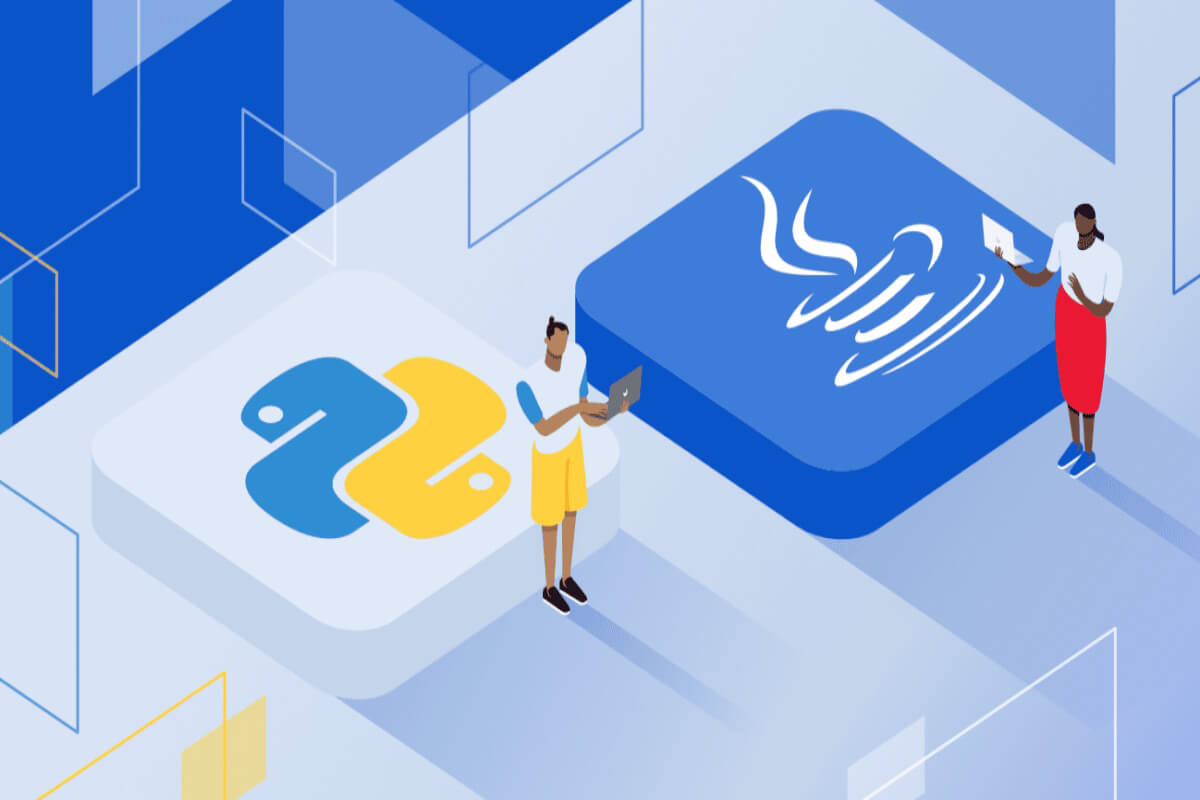
Just as we see fierce competition between tech giants and fast-food chains, the programming world has its own epic battle – Java vs Python. This showdown has left many individuals who wish to be developers and existing developers confused about which one to go for.
Let us make it a bit more practical – let us think that you are at a crossroads in your coding progression. On one side you have the reliable and established Java and on the other hand, you have the modern and adaptable Python. It is a decision that many professionals in the tech industry have had to make, and it is not easy. You need to think of the battle Python vs Java from every angle and choose the one that suits your project.
In the past few decades, there has been a tremendous increase in the availability of programming languages. However, in this context, Java and Python have not only continued to endure but also remain dominant programming languages since the start of the new millennium. This is the flexibility and continued viability in an increasingly technological world.
But what makes Python vs. Java so interesting? How they have been able to maintain the position knowing that more and more entrants seem to be emerging on the scene? And most importantly, can one actually overpower the other?
What is Java?
Java is a virtual programming language that was invented in 1995 by Sun Microsystems, and it embraces the concept of the OOP (object-oriented programming) language with as little implementation as possible. Its major principle is called ‘Write Once, Run Anywhere’ which focuses on portability, and lets one create apps for usage on any compatible device using the JVM – Java Virtual Machine.
Use cases of Java
Java’s robustness and versatility make it suitable for a wide range of applications:
- Enterprise applications: Java is extensively used in the development of vast server-based, multi-timer applications, especially in corporate settings. Technologies such as Java EE (Enterprise Edition) and Spring help in the creation of applications that include tiers for complex applications.
- Android mobile development: Java is still one of the dominant programming languages used to create Android applications, using the Android SDK.
- Web applications: Java is widely used to create many server-side web applications which use frameworks including SpringBoot, JavaServer Faces (JSF), and Struts.
- Big data technologies: Almost all popular big data processing frameworks like Apache Hadoop and Apache Spark use Java language for programming, which makes it important in the big data domain.
What is Python?
Python language was developed by Guido van Rossum in 1991. Python is an interpreted scripting language characterized by its clear syntax. The language has the remarkable concept of a significant white line that makes the understandable design more perusable.
Use cases of Python
Python’s versatility and ease of use have led to its adoption in numerous fields –
- Data Science and Machine Learning: python is the most used programming language when it comes to data analysis and Machine Learning – thanks to its libraries such as Scikit-learn, Pandas, and NumPy.
- Artificial Intelligence: Machine Learning libraries like TensorFlow and Pytorch have made Python a popular programming language for AI development and research.
- Web development: Python is extensively used in developing web applications with Flask and Django being some of the most popular frameworks.
- Automation and scripting: for ease of understanding, Python allows the use of scripts to build different automation and processes.
Let us get into the battle of Java vs Python
Type of Languages
Python
Python, as stated earlier, is an interpreted and dynamically typed language. It means:
- At run time, the code is executed line by line.
- It is dynamic which means the required variable types are decided at runtime and can be altered.
- There is a need for obvious type declarations.
- It is a more flexible mode of coding but possesses the risk of runtime error if it’s not well managed and executed.
Java
On the other hand, Java is a compiled and statically typed language. It means:
- The code is converted to another form known as bytecode before it is executed.
- Variables have to be declared and the use of different variable types is defined at the time of compilation.
- It gives better type checking where any type of effort is pointed out right from the development stage.
- Usually performs better because of code tweaks during compilation.
Syntax and Coding
Python
Python’s syntax is known for its simplicity and readability:
- Has proper indentation for code blocks, thus enforcing clean code formatting.
- There are usually fewer code lines required to execute a task.
- Favours a ‘there is only one good way to do it’ concept.
- Does not include static typing, which means variable types don’t have to be defined.
Example:
def greet(name):
print(f”Hello, {name}!”)
greet(“World”)
Java
Java’s syntax is more wordy and structured:
- Denotes code snippets with curly braces.
- Requires using semicolons at the end of each statement.
- Adheres to very high standards of Object-Oriented Programming (OOP) paradigms.
- The programmer must declare the type of variables and the return type of the methods.
public class Greeting {
public static void greet(String name) {
System.out.printIn(“Hello,” + name + “!”);
}
public static void main(String[] args) {
greet(“World”);
}
}
Ease of Use
Python
Python is renowned for its ease of use:
- Easy language, capable of being understood, especially by entry-level programmers.
- It has a vast standard library – the Python Standard Library for all types of operations.
- REPL is an interactive shell that is used for quick testing as well as for prototyping.
- Less boilerplate code is required for many tasks.
Java
Java has a steeper learning curve but offers benefits:
- Wordy syntax can be more complex which is confusing to those who are new to programming.
- Type safety and adherence to OOP well-established guidelines ensure that the coders write quality code.
- Integrated environments that are full of features and with advanced debugging capabilities help in development.
- Has the standard library size, but sometimes needs additional import statements for a particular project.
App Performance and Stability
Python
Python’s performance characteristics:
- In some cases, it may take longer to execute its code because it is an interpreted language.
- Multithreading and the Global Interpreter Lock (GIL) can be a problem for certain programs.
- Ideal for fast prototyping and concept creation.
- Despite this, it is possible to optimize performance using tools such as PyPy or Cython.
Java
Java’s performance and stability features:
- Generally, faster execution because of Just-in-Time (JIT) compilation.
- Very good at concurrent programming, including multiple threads.
- Type-checking leads to more detected errors during compilation, thus increasing system stability.
- Consistent performance across different platforms due to JVM.
Mobile App Development
Python
Python in mobile app development:
- Has not been associated with native mobile application development in the past.
- Kivy and BeeWare are the most convenient frameworks that facilitate cross-platform mobile development.
- Backend services in mobile apps can be developed in Python.
- Not usually the first preference for mobile applications that require optimal performance.
Java
Java in mobile development:
- The default language for developing native Android applications.
- The rich environment of tools and frameworks available for developing applications for Android.
- Provides high performance while at the same time integrating well with the Android software development kit.
- Can also be used in cross-platform application development with some frameworks such as JavaFX Mobile.
Coding Speed
Python
Python’s impact on coding speed:
- Simplicity of syntax facilitates fast development and the creation of prototypes.
- Fewer lines have to be written and maintained as there is less of the boilerplate code.
- The availability of a large number of libraries and frameworks helps in reducing development time.
- Interpreted nature can be experimented with and fine-tuned swiftly.
Java
Java’s impact on coding speed:
- There is a tendency to extend coding time when using a language with more wordy syntax.
- Statically typed languages and compile-time checks can be valuable because errors are discovered earlier.
- Quality IDEs that come with code generation functions are effective in increasing efficiency; however, larger projects might be served well in the long run with Java.
Agile and DevOps
Python
Python in Agile and DevOps
- It is more suitable for projects that need many prototypes and changes in the software product development process, especially when using the Agile method.
- Works well with scripting and automation in the DevOps pipeline.
- Used when working with configuration management tools like Ansible.
- Simple design makes it easier to introduce changes and add new features.
Java
Java in Agile and DevOps
- Robust testing frameworks support test-driven development in Agile.
- Stable and predictable performance is beneficial for DevOps practices.
- Strong typing and compile-time checks align with DevOps principles of reliability.
- Containerization support with tools like Docker facilitates DevOps practices.
Learning Curve
Python
Python’s learning curve:
- Generally considered one of the easiest languages to learn.
- Immediate feedback through the interpreter aids learning.
- Abundance of learning resources and supportive community.
- Can be challenging to transition to other languages due to its unique syntax.
Java
Java’s learning curve:
- Steeper initial learning curve due to more complex syntax and concepts.
- Static typing and wordy syntax can be challenging for novices.
- Excellent for learning software engineering principles and design patterns.
- A strong foundation in Java can make learning other languages easier.
Which language is used more?
As of 2024, both Python and Java continue to dominate the programming landscape, but their usage patterns and growth trajectories differ significantly.
Python has seen explosive growth in recent years, particularly in fields like data science, Artificial Intelligence, and web development. According to the TIOBE Index and Stack Overflow’s Developer Survey, Python consistently ranks as one of the most popular programming languages. Its rise can be attributed to:
- The booming field of data science and Machine Learning.
- Increased adoption in academic and scientific communities.
- Growing popularity in web development, especially for backend services.
- Its versatility and ease of use for startups and rapid prototyping.
Java, while experiencing slower growth compared to Python, maintains a strong presence in the programming world. It remains widely used in:
- Enterprise-level applications.
- Android mobile development.
- Lare-scale web services.
- Financial services and banking systems.
Future of Java vs Python
Looking ahead, both languages are poised to play significant roles in shaping the future of technology, although in slightly different domains.
Python’s future looks incredibly bright:
- Continued dominance in AI and Machine Learning.
- Expanding role in data science and big data analytics.
- Growing adoption of IoT and embedded systems.
- Ongoing improvements in performance (like Python 3.11’s speed boosts).
Java’s future is bright with focus on:
- Enhanced support for cloud-native apps and microservices.
- Improvements in JVM performance and reduced memory footprint.
- Better integration with modern development practices such as serverless computing.
- Continued evolution of the language (like Project Amber for language feature improvements).
Which language should I choose as a client?
When choosing between Python and Java for mobile app development, focus on your business requirements. Python for business offers flexibility and rapid development, especially for prototyping and backend services, while Java is a reliable choice—particularly for Android apps—offering scalability, robustness, and a vast library ecosystem. It is supported by an already well-developed community, assuring sufficient and appropriate resources during development.
Python is widely used due to its simplicity and high speed of creating working prototypes; thus, it is suitable for creating a minimum viable product (MVP). Nevertheless, frameworks such as Kivy for creating mobile apps with Python may not be as robust as Java’s, potentially affecting performance in complex applications. Your choice should align with your project’s specific requirements and long-term goals.
Conclusion
As we have explored throughout this guide, both Java and Python stand as pillars in the programming world. Each has its own unique strengths and use cases. Python’s simplicity and versatility have fueled its rapid growth, particularly in emerging fields like data science and AI. On the other hand, Java is an excellent choice for Android applications and for large projects that require complex operations.




